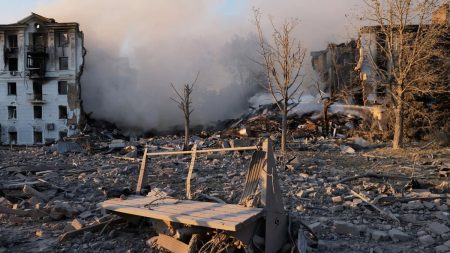The ongoing conflict between Russia and Ukraine witnessed a significant escalation in drone and missile attacks over the weekend, marking a new phase in the war’s trajectory. The exchange of fire extended far beyond the established front lines, reaching deep into Russian territory and highlighting the evolving nature of the conflict. A Ukrainian drone strike on a National Guard facility in the Chechen capital of Grozny, located hundreds of kilometers from the front, underscored Kyiv’s growing capacity to project power and its willingness to target symbolic and strategic locations within Russia. This attack, while causing no reported casualties, served as a stark reminder of the conflict’s expanding reach and its potential to destabilize regions previously considered safe.
Chechen leader Ramzan Kadyrov’s furious response to the drone strike, vowing retaliation and claiming a subsequent missile strike on Kharkiv, further fueled tensions. Kadyrov’s pronouncements, while not independently verified, emphasized the volatile nature of the conflict and the potential for further escalation. The incident in Grozny, coupled with Russia’s reported downing of numerous Ukrainian drones over its Kursk and Belgorod regions and the Black Sea, painted a picture of an intensifying drone war. This increasing reliance on unmanned aerial vehicles reflects both sides’ efforts to minimize human casualties and maximize strategic impact, even as it raises concerns about the potential for unintended escalation and the blurring of traditional battle lines.
Adding another layer of complexity to the conflict, a Ukrainian security official revealed a covert operation targeting Russian fuel supply lines in occupied Zaporizhzhia. This sabotage mission, involving the destruction of a locomotive and numerous tanker cars, aimed to disrupt Russia’s logistical capabilities and hinder its military operations in the region. The use of HIMARS rocket launch systems in the attack further highlighted the increasing sophistication and effectiveness of Ukrainian tactics, targeting critical infrastructure and supply chains to weaken the Russian war effort. This attack, coupled with the drone strikes, demonstrates Kyiv’s proactive approach to disrupting Russian operations and its willingness to take the fight deep into enemy-held territory.
The weekend’s events followed a massive Russian bombardment on Friday, which saw a barrage of missiles and drones targeting Ukraine’s energy infrastructure. This sustained assault on critical infrastructure reflects Moscow’s strategy of weakening Ukraine’s resilience and disrupting essential services, aiming to demoralize the population and cripple the country’s ability to function. The escalating attacks from both sides underscore the increasingly brutal nature of the conflict and the immense challenges facing civilians caught in the crossfire. The ongoing targeting of civilian infrastructure raises serious humanitarian concerns and underscores the urgent need for a peaceful resolution.
Amidst these escalating tensions, Russian forces continued to make advances in eastern Ukraine, notably in the besieged settlement of Kurakhove. This persistent push highlights Moscow’s ongoing territorial ambitions and its determination to consolidate its control over strategic areas in the east. The ground fighting, combined with the intensifying aerial warfare, paints a grim picture of a protracted and increasingly destructive conflict. The continued fighting and territorial gains underscore the challenges facing Ukraine in defending its sovereignty and the urgent need for international support to counter the Russian offensive.
Adding to the uncertainty surrounding the conflict’s future is the evolving political landscape in the United States. The incoming administration’s potential shift in policy regarding Ukraine’s use of American-supplied weapons to strike Russian territory adds another layer of complexity to an already volatile situation. President-elect Donald Trump’s expressed reservations about such strikes raise questions about the long-term trajectory of American support for Ukraine and the potential implications for the balance of power in the region. This uncertainty creates a precarious backdrop for the conflict, adding to the challenges facing both Ukraine and the international community in navigating the complex dynamics of the war and seeking a peaceful resolution. The evolving political situation underscores the critical need for clear and consistent communication between allies and a unified approach to addressing the ongoing crisis.














